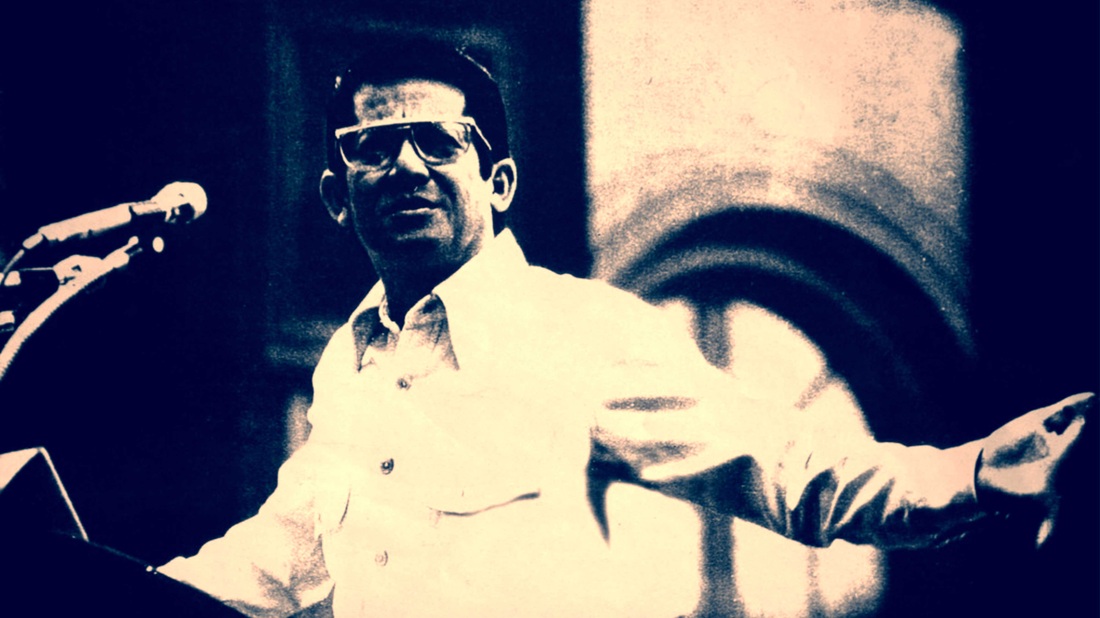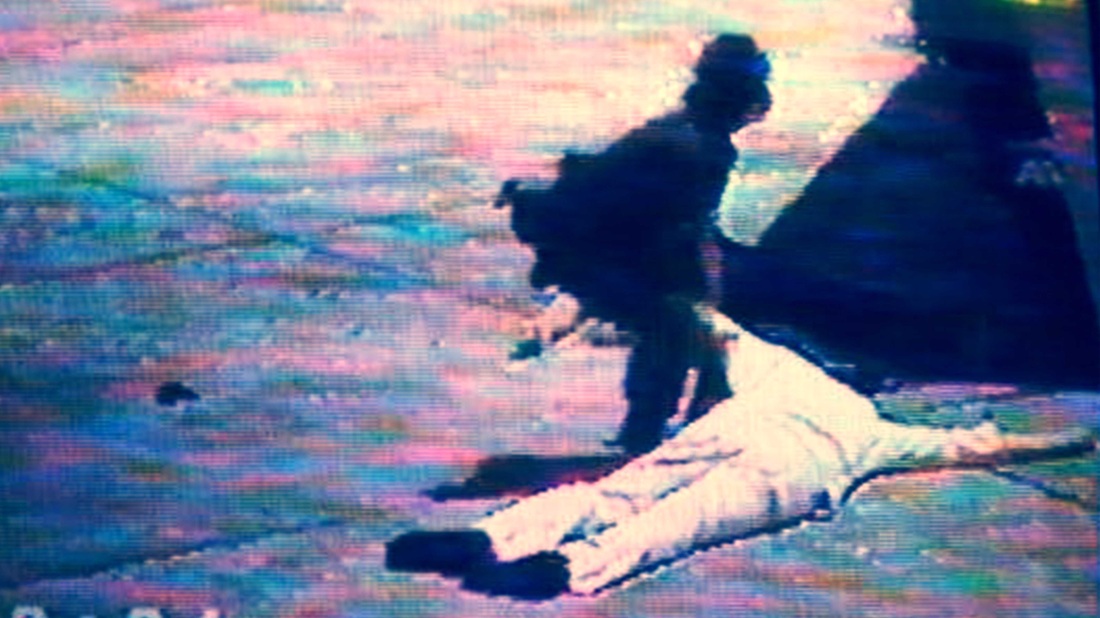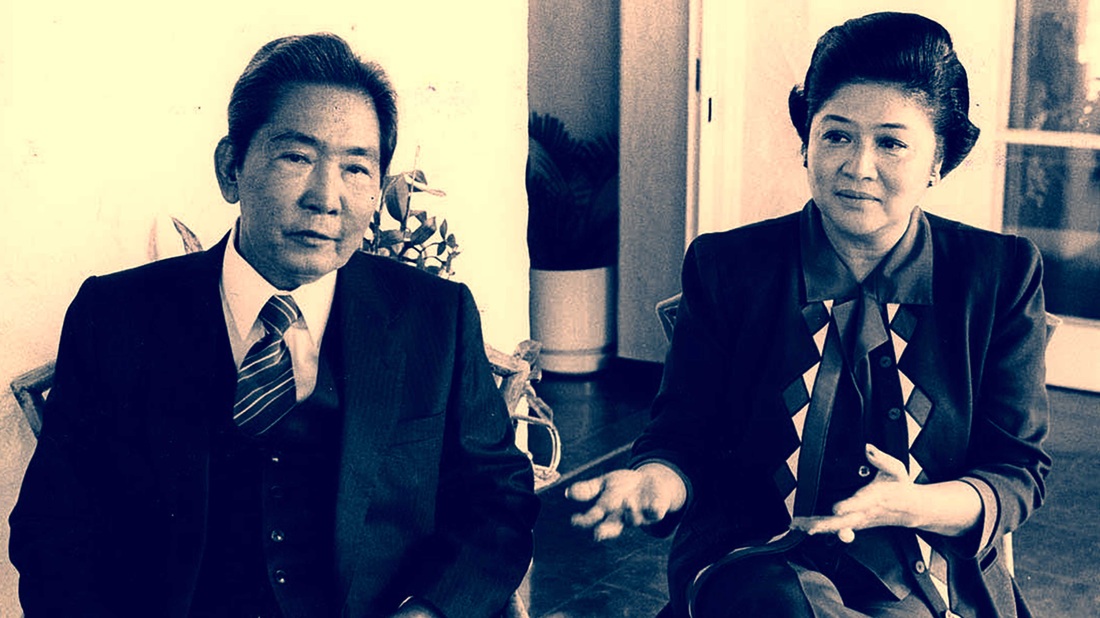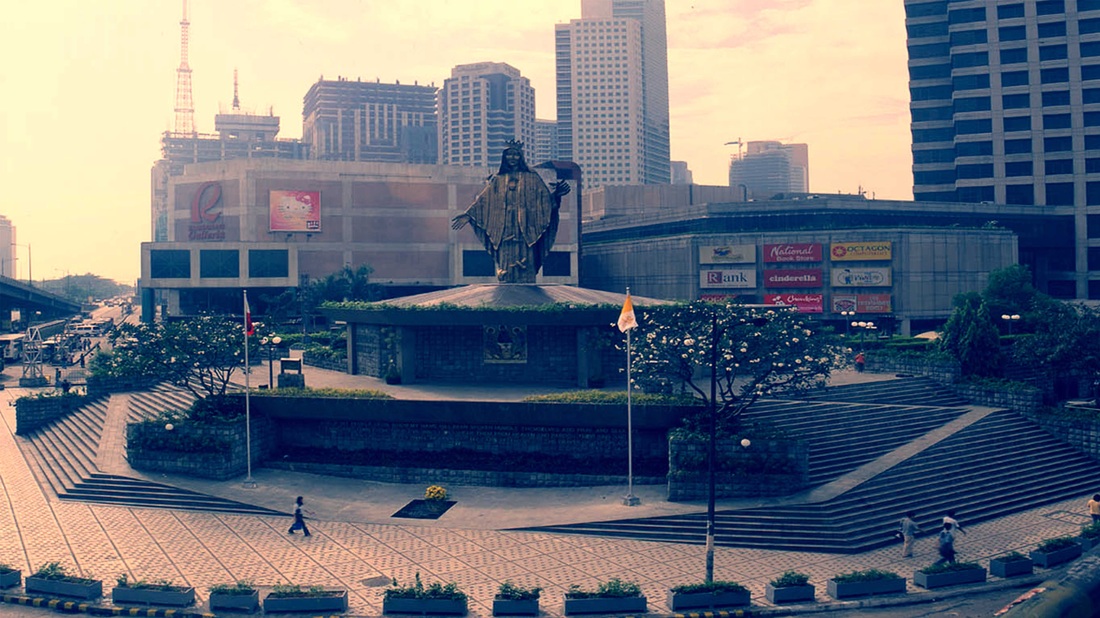The so called “Yellow Revolution, EDSA Revolution, People Power Revolution” which toppled the 21-year dictatorship regime of President Ferdinand Marcos in February 25, 1986. The revolution that changes the whole course of Philippine history it also serves as an inspiration for other countries to fight for their democracy. As what CBS anchorman Bob Simon reported: “We Americans like to think we taught the Filpinos democracy. Well, tonight they are teaching the world”.
The Philippines headlined in the newspapers worldwide, a peaceful revolt led by a woman named María Corazón Sumulong Cojuangco Aquino known as Cory Aquino, a self-proclaimed simple housewife yet the first woman and the 11th President of the Philippines and the first female President in Asia. She is also the first President without any political experience as she had not held any other elective office. Regarded as the "Icon of Philippine Democracy" and was named “Woman of the Year” of the Time magazine in 1986.
The Philippines headlined in the newspapers worldwide, a peaceful revolt led by a woman named María Corazón Sumulong Cojuangco Aquino known as Cory Aquino, a self-proclaimed simple housewife yet the first woman and the 11th President of the Philippines and the first female President in Asia. She is also the first President without any political experience as she had not held any other elective office. Regarded as the "Icon of Philippine Democracy" and was named “Woman of the Year” of the Time magazine in 1986.
Her political career started after her husband Senator Benigno “Ninoy” Aquino was assassinated on Sunday, August 21, 1983 at Manila International Airport upon returning to the country after a 3-year self-exile in the United States. Ninoy is known as a longtime political rival of President Ferdinand Marcos. He was elected as a senator in 1967 and shortly thereafter began speaking out against the Marcos’ regime.
Though Marcos and Aquino was fraternity brother, Aquino blasted Marcos for setting up a militarized government, and for corruption and extravagance. He also condemned Marcos’s financial policies and enormous military outlays.
After the declaration of Martial Law in September 21, 1972 Ninoy was imprisoned on trumped up charges of murder and subversion and was convicted on all charges and sentenced to death. However, since Aquino had gained support while imprisoned, he believed that Marcos would not allow executing him since it would make a negative publicity on him.
Though Marcos and Aquino was fraternity brother, Aquino blasted Marcos for setting up a militarized government, and for corruption and extravagance. He also condemned Marcos’s financial policies and enormous military outlays.
After the declaration of Martial Law in September 21, 1972 Ninoy was imprisoned on trumped up charges of murder and subversion and was convicted on all charges and sentenced to death. However, since Aquino had gained support while imprisoned, he believed that Marcos would not allow executing him since it would make a negative publicity on him.
While in prison, he founded his political party, “Lakas ng Bayan” (LABAN) to run for the parliament positions, but all his candidates loss to Marcos’s party. In 1980 he suffered a heart attack while in prison, while in the Philippine Heart Center he suffered a seond heart attack, it was then determined by the doctors that he needed coronary artery bypass surgery, but no surgeon wanted to perform the operation out of fear of the controversy, Ninoy also refused to undergo the procedure out of fear of sabotage by the Marcos’. He would only go either in the US or die in his prison cell.
On May 8, 1980, Ninoy was allowed to leave the country for the US by First Lady Imelda Marcos the wife of Ferdinand Marcos to undergo his coronary bypass procedure; he has spent the next three years in exile in the US. By 1983, Ninoy return to his homeland because of the news about the political situation in the country. Despite the attempts of the government to block his return, he still continued, and on August 21, 1983, he landed in Manila International Airport wherein he was assassinated.
On May 8, 1980, Ninoy was allowed to leave the country for the US by First Lady Imelda Marcos the wife of Ferdinand Marcos to undergo his coronary bypass procedure; he has spent the next three years in exile in the US. By 1983, Ninoy return to his homeland because of the news about the political situation in the country. Despite the attempts of the government to block his return, he still continued, and on August 21, 1983, he landed in Manila International Airport wherein he was assassinated.
The assassination and death of Ninoy fuel up the emotion of the whole country. During his necrological service his body lays in a glass coffin and no effort was made to masked up the bullet wound that had disfigured his face. In an interview to his mother, Doña Aurora A. Aquino, she told the funeral parlor not to apply makeup nor embalm her son, to see "what they did to my son". She also played a vital role in the political battles that followed her son’s assassination; she also campaigned vigorously for her daughter-in-law Corazon C. Aquino during the 1986 snap elections in a bid to unseat resident Marcos.
Thousands of his supporters gathered to see his remains and during the funeral procession on August 31 which lasted 12-hour long funeral procession. His funeral mass was held at Santo Domingo Church in Santa Mesa Heights, Quezon City, with the the CardinalArchbishop of Manila, Jaime Sin officiating. When his body was interred at Manila Memorial Park, more than two million people lined the streets during the procession. Many commentators compared Ninoy with Jose Rizal and were eulogized by the leader of Liberal Party as "the greatest president we never had."
His widow Corazon C. Aquino, a shy, simple and plain housewife who never imagine she would held government office, a Presidential position, was inspired by the outpouring support she received after Ninoy’s death and was indeed became a leader of the anti-Marcos movement.
Thousands of his supporters gathered to see his remains and during the funeral procession on August 31 which lasted 12-hour long funeral procession. His funeral mass was held at Santo Domingo Church in Santa Mesa Heights, Quezon City, with the the CardinalArchbishop of Manila, Jaime Sin officiating. When his body was interred at Manila Memorial Park, more than two million people lined the streets during the procession. Many commentators compared Ninoy with Jose Rizal and were eulogized by the leader of Liberal Party as "the greatest president we never had."
His widow Corazon C. Aquino, a shy, simple and plain housewife who never imagine she would held government office, a Presidential position, was inspired by the outpouring support she received after Ninoy’s death and was indeed became a leader of the anti-Marcos movement.
In November 1895, pressure forced President Marcos to declare a snap election during an interview on the American Broadcasting Company political affairs program, This Week with David Brinkley. On December 3, 1985, Batasang Pambansa passed a law setting the date of election on February 7, 1986.
Cory Aquino was the standard bearer of the opposition against Marcos. The said election were marred with reports of cheating and fraud, The Commission on Elections (COMELEC) declared Marcos as the winner but a contradicting results from National Movement for Free Elections (NAMFREL) declared Cory.
It was on February 9, 1986 the PICC Walkout wherein 30 computer programmers walked out of the COMELEC’s electronic quick count at the Philippine International Convention Center (PICC), they claimed that Marcos camp had manipulated the elections result.
More reports of electoral fraud caused the Catholic Bishops Conference of the Philippines to issue a statement condemning the elections as well as the US Senate. This chain of events eventually led to the resignation of Marcos’ Defense Minister, Juan Ponce Enrile and Armed Forces Vice-Chief of Staff General Fidel Ramos.
Cory Aquino was the standard bearer of the opposition against Marcos. The said election were marred with reports of cheating and fraud, The Commission on Elections (COMELEC) declared Marcos as the winner but a contradicting results from National Movement for Free Elections (NAMFREL) declared Cory.
It was on February 9, 1986 the PICC Walkout wherein 30 computer programmers walked out of the COMELEC’s electronic quick count at the Philippine International Convention Center (PICC), they claimed that Marcos camp had manipulated the elections result.
More reports of electoral fraud caused the Catholic Bishops Conference of the Philippines to issue a statement condemning the elections as well as the US Senate. This chain of events eventually led to the resignation of Marcos’ Defense Minister, Juan Ponce Enrile and Armed Forces Vice-Chief of Staff General Fidel Ramos.
Enrile and Ramos then secluded themselves in the military and police headquarters of Camp Aguinaldo and Camp Crame that leads to the People Power Revolution. At about 9 p.m. the highly influential Archbishop of Manila, Jamie Sin aired a message over Radyo Veritas that encouraged Filipinos to aid rebel leaders by going to the section of EDSA between Camp Crame and Camp Aguinaldo to give emotional support, food and other supplies.
Many people, specially nuns and priests trooped to EDSA amidst the barricade and military power by the government. An estimated of over three million people makes their stand against the government and filled EDSA from Ortigas Avenue all the way to Cubao. Though it is a revolution, the mood of the street was very festive, with many bringing their whole families. Known performers entertain the crowds, nuns and priests led prayer vigils, people set up barricades and makeshift sandbags, trees and vehicle. Several groups sang the patriotic national anthem of the opposition, Bayan Ko. People frequently flashed the LABAN sign which is a “L” formed with the thumb and the index finger.
During the height of the revolution, a contingent of Marines with tanks and armored vans was stopped from Ortigas Avenue by tens of thousands of people, nuns holding rosaries knelt in front of the tanks, men and women linked arms together to block the troops.
Many people, specially nuns and priests trooped to EDSA amidst the barricade and military power by the government. An estimated of over three million people makes their stand against the government and filled EDSA from Ortigas Avenue all the way to Cubao. Though it is a revolution, the mood of the street was very festive, with many bringing their whole families. Known performers entertain the crowds, nuns and priests led prayer vigils, people set up barricades and makeshift sandbags, trees and vehicle. Several groups sang the patriotic national anthem of the opposition, Bayan Ko. People frequently flashed the LABAN sign which is a “L” formed with the thumb and the index finger.
During the height of the revolution, a contingent of Marines with tanks and armored vans was stopped from Ortigas Avenue by tens of thousands of people, nuns holding rosaries knelt in front of the tanks, men and women linked arms together to block the troops.
Due to the encouragement of Ramos and Enrile to their fellow soldiers, the majority of the Armed Forces have already changed side. This was evident when a rebel helicopter attacked Villamor Airbase, destroying presedenial air assets and another one who went to Malacañang that caused a minor damaged.
At around 7 a.m. of February 25, 1986, Corazon Aquino was inaugurated as the President of the Philippines and Salvador Laurel as her Vice President in a simple ceremony at Club Filipino in Greenhills. Ramos and Enrile were present in Cory’s inauguration among many politicians and the hundreds of Filipino who wore yellow are cheering and celebrating after Aquino’s oath-taking.
An hour later at Malacañang, Marcos also conducted his inauguration and immediately rushed to leave the palace with their associates. He leaves the country and goes to Hawaii where he arrived on February 26, 1986. When the news of Marcos’s departure reached the people, many rejoiced and danced in the streets. The people entered Malacañang and looting by angry protester occurred.
At around 7 a.m. of February 25, 1986, Corazon Aquino was inaugurated as the President of the Philippines and Salvador Laurel as her Vice President in a simple ceremony at Club Filipino in Greenhills. Ramos and Enrile were present in Cory’s inauguration among many politicians and the hundreds of Filipino who wore yellow are cheering and celebrating after Aquino’s oath-taking.
An hour later at Malacañang, Marcos also conducted his inauguration and immediately rushed to leave the palace with their associates. He leaves the country and goes to Hawaii where he arrived on February 26, 1986. When the news of Marcos’s departure reached the people, many rejoiced and danced in the streets. The people entered Malacañang and looting by angry protester occurred.
The cause of EDSA People Power Revolution in 1986 is merely politics, two big names clashing to sit as the highest official of our republic; the one is already sitting while the other wants to topple the old system and promises to change the system. Sound familiar isn’t it? Yes, it is our political culture in the Philippines, when somebody is sitting in a position a name will be coming out and would promise a reform. A change that will be soon promised by another standard bearer by the time he sees a hole and irregularities.
History repeats itself, the original characters may not be present but the plot and summary of the story is just the same. Ninoy, Cory and Marcos were not here anymore with us, but their political-novela will always be a blockbuster hit in our minds. They may have moved our country this far, but the question is, does they reach the change that they have promised? Their best supporting casts like Ramos and Enrile became a political giant in the country indeed Ramos became the next president of the republic when Cory’s term ended. Both of them became one of the most influential political personalities in the country up to this time.
The casts and crew of the said Yellow Revolution benefited as Marcos step down, the congress that Marcos dissolved during martial law has go back to its normal routine. The legislature branch that is been accused as the cradle of anomalies and corruption, the senators and representatives who is been linked to the PORK BARREL SCANDAL who stolen the billion fund that could support their constituents.
The freedom of speech, the freedom of the press and many other civil liberties has been restored. Every Filipinos believed that they have achieved democracy but they were wrong, what they have achieved is a definition of democracy given by their own thoughts and given by the main characters of the so called political-novela, these definition will live though and is their living legacy.
History repeats itself, the original characters may not be present but the plot and summary of the story is just the same. Ninoy, Cory and Marcos were not here anymore with us, but their political-novela will always be a blockbuster hit in our minds. They may have moved our country this far, but the question is, does they reach the change that they have promised? Their best supporting casts like Ramos and Enrile became a political giant in the country indeed Ramos became the next president of the republic when Cory’s term ended. Both of them became one of the most influential political personalities in the country up to this time.
The casts and crew of the said Yellow Revolution benefited as Marcos step down, the congress that Marcos dissolved during martial law has go back to its normal routine. The legislature branch that is been accused as the cradle of anomalies and corruption, the senators and representatives who is been linked to the PORK BARREL SCANDAL who stolen the billion fund that could support their constituents.
The freedom of speech, the freedom of the press and many other civil liberties has been restored. Every Filipinos believed that they have achieved democracy but they were wrong, what they have achieved is a definition of democracy given by their own thoughts and given by the main characters of the so called political-novela, these definition will live though and is their living legacy.
Sources:
http://malacanang.gov.ph/4538-dona-aurora-a-aquino-on-her-son-ninoy/
http://asianhistory.about.com/od/philippines/p/Biography-of-Ninoy-Aquino.htm
http://www.ninoyaquino.ph/
http://en.wikipedia.org/wiki/Philippine_presidential_election,_1986
http://en.wikipedia.org/wiki/History_of_the_Philippines_(1965-1986)
http://malacanang.gov.ph/4538-dona-aurora-a-aquino-on-her-son-ninoy/
http://asianhistory.about.com/od/philippines/p/Biography-of-Ninoy-Aquino.htm
http://www.ninoyaquino.ph/
http://en.wikipedia.org/wiki/Philippine_presidential_election,_1986
http://en.wikipedia.org/wiki/History_of_the_Philippines_(1965-1986)









